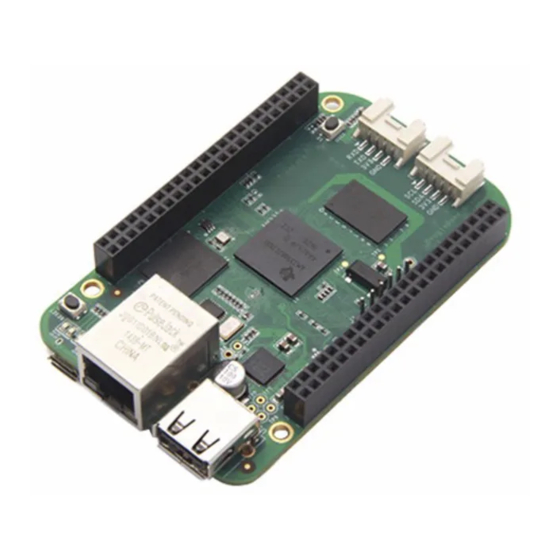Subscribe to Our Youtube Channel
Summary of Contents for Seeed Beaglebone green
- Page 1 Beaglebone green User Manual Release date: 2015/9/22 Version: Wiki: http://www.seeedstudio.com/wiki/Beaglebone_green Bazaar: http://www.seeedstudio.com/depot/BeagleBone-Green-p- 2504.html?cPath=122_113...
- Page 2 Document Revision History Revision Date Author Description Sep 22, 2015 Loovee Create file...
-
Page 3: Table Of Contents
Contents Document Revision History · · · · · · · · · · · · · · · · · · · · · · · · · · · · · · · · · · · · · · · · · · · · · · · · · · · · · · · · · · · · · · · · · · · · · · · · · 2 1. - Page 5 Under the supervision of Seeed Technology Inc., this manual has been compiled and published which covered the latest product description and specification. The content of this manual is subject to change without notice.
-
Page 6: Document Revision History
1. Introduction BeagleBone Green (BBG) is based on the classical open-source hardware design of BeagleBone Black (BBB) and added two Grove connectors. It has removed the HDMI port on the BBB and also updated the 5V barrel to Micro USB host. It is a low-cost, community-supported development platform for developers and hobbyists. -
Page 7: Technical Details
2. Technical Details Processor AM335x 1GHz ARM® Cortex-A8 512MB DDR3 RAM 4GB eMMC on-board flash storage 3D graphics accelerator NEON floating-point Software Compatibility Debian Android Ubuntu Cloud9 IDE on Node Support much more Connectivity ... -
Page 8: Hardware Overview
3. Hardware Overview Seeed.cc's BeagleBoneGreen page documents all of the known hardware issues, as well as the latest available software, hardware documentation and design materials. Always read the System Reference Manual! Design materials Design materials for creating your own customized version of the hardware, or for better understanding the design are also linked from the traditional home of http://beagleboard.org/hardware/design... -
Page 9: Headers
Headers The expansion headers provide extensive I/O capabilities. Cape Expansion Headers 3.2.1 Each digital I/O pin has 8 different modes that can be selected, including GPIO. 65 Possible Digital I/Os 3.2.2 In GPIO mode, each digital I/O can produce interrupts. -
Page 10: Pwms And Timers
PWMs and Timers 3.2.3 Up to 8 digital I/O pins can be configured with pulse-width modulators (PWM) to produce signals to control motors or create pseudo analog voltage levels, without taking up any extra CPU cycles. -
Page 11: Analog Inputs
Analog Inputs 3.2.4 analog- Make sure you don't input more than 1.8V to the analog input pins. This is a single 12-bit to-digital converter with 8 channels, 7 of which are made available on the headers. 3.2.5 UART There is a dedicated header for getting to the UART0 pins and connecting a debug cable. Five additional serial ports are brought to the expansion headers, but one of them only has a single direction brought to the headers. -
Page 12: I2C
3.2.6 The first I2C bus is utilized for reading EEPROMS on cape add-on boards and can't be used for other digital I/O operations without interfering with that function, but you can still use it to add other I2C devices at available addresses. The second I2C bus is available for you to configure and use. -
Page 13: Spi
3.2.7 For shifting out data fast, you might consider using one of the SPI ports. -
Page 14: Software
Beagle and the software resources by http://beagleboard.org/Support/Software+Support click Getting Started Beaglebone Green is a tiny computer with all the capability of today’s desktop machines, without the bulk, expense, or noise. Read the step-by-step getting started tutorial by http://beagleboard.org/getting-started click to begin developing with your BeagleBone in minutes. -
Page 15: Update Image
The BeagleBone Green that can be initialized by a program booted off of a microSD card. If you want to update to the latest software image for your board, this is a way to do that. -
Page 16: Step2: Install Compression Utility
The file you download will have an .img.xz extention. This is a compressed sector-by-sector image of the SD card. 4.4.2 Step2: Install compression utility http://www.7-zip.org/download.html Download and install 7-zip by click 4.4.3 Step3: Decompress the image Use 7-zip to decompress the SD card .img file 4.4.4... -
Page 17: Step7: Eject The Sd Card
USB cable or 5V adapter. If using an original white BeagleBone, you are done. If using BeagleBone Green and the image is meant to program your on-board eMMC, you'll need to wait while the programming occurs. -
Page 18: Resources
5. Resources BEAGLEBONE_GREEN SRM(pdf) BEAGLEBONE_GREEN Schematic(pdf) BEAGLEBONE_GREEN Schematic(OrCAD) BEAGLEBONE_GREEN BOM(xls) ... - Page 19 Mouser Electronics Authorized Distributor Click to View Pricing, Inventory, Delivery & Lifecycle Information: BeagleBoard 102010027...










Need help?
Do you have a question about the Beaglebone green and is the answer not in the manual?
Questions and answers